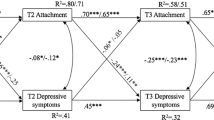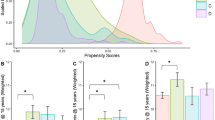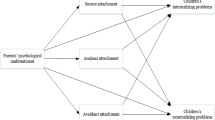Abstract
Previous research has shown that children with high levels of early anxiety/withdrawal are at increased risk of later anxiety and depression. It has also been found that positive parent–child attachment reduces the risk of these disorders. The aim of this paper was to examine the extent to which positive parent–child attachment acted to mitigate the risk of later internalising disorders amongst children with high levels of early anxiety/withdrawal using data from a 30 years longitudinal study of a New Zealand birth cohort. The findings of this study showed that: (a) increasing rates of early anxiety/withdrawal were associated with an increased risk of later anxiety and depression; (b) positive parent–child attachment in adolescence was associated with a decline in the risk of later anxiety and depression; and (c) these associations persisted even after controlling for confounding factors. The implications of these findings for the role of parent–child attachment in mitigating the adverse effects of early anxiety/withdrawal are discussed. It is concluded that positive parent–child attachment in adolescence may act as a compensatory factor which buffers the adverse effects of childhood anxiety/withdrawal on risks of developing later anxiety and depression.
Similar content being viewed by others
References
Achenbach, T. M., & Edelbrock, C. S. (1978). The classification of child psychopathology: A review and analysis of empirical efforts. Psychological Bulletin, 85, 1275–1301.
Armsden, G., & Greenberg, M. (1987). The inventory of parent and peer attachment: Individual differences and their relationship to psychological well-being in adolescence. Journal of Youth and Adolescence, 16(5), 427–454.
Armsden, G., McCauley, E., Greenberg, M., Burke, P., & Mitchell, J. (1990). Parent and peer attachment in early adolescent depression. Journal of Abnormal Child Psychology, 18(6), 683–697.
Barlow, D. H. (2002). Anxiety and its disorders: The nature and treatment of anxiety and panic. New York, NY: Guilford Press.
Bettmann, J., & Friedman, D. (2010). Preface to the special issue on child and adolescent attachment. Clinical Social Work Journal, 38(1), 1–3.
Bittner, A., Egger, H., Erkanli, A., Costello, E. J., Foley, D., & Angold, A. (2007). What do childhood anxiety disorders predict? Journal of Child Psychology and Psychiatry, 48(12), 1174–1183.
Bittner, A., Goodwin, R., Wittchen, H., Beesdo, K., Hofler, M., & Lieb, R. (2004). What characteristics of primary anxiety disorders predict subsequent major depressive disorder. Journal of Clinical Psychiatry, 65(5), 618–626.
Brumariu, L., & Kerns, K. (2010). Parent–child attachment and internalizing symptoms in childhood and adolescence: A review of empirical findings and future directions. Development and Psychopathology, 22(01), 177–203.
Buist, K., Dekovi, M., Meeus, W., & van Aken, M. (2004). The reciprocal relationship between early adolescent attachment and internalizing and externalizing problem behaviour. Journal of Adolescence, 27(3), 251–266.
Caspi, A., Moffitt, T. E., Newman, D. L., & Silva, P. A. (1996). Behavioral observations at age 3 years predict adult psychiatric disorders: Longitudinal evidence from a birth cohort. Archives of General Psychiatry, 53(11), 1033–1039.
Clark, C., Caldwell, T., Power, C., & Stansfeld, S. (2010). Does the influence of childhood adversity on psychopathology persist across the lifecourse? A 45-year prospective epidemiologic study. Annals of Epidemiology, 20(5), 385–394.
Conners, C. K. (1969). A teacher rating scale for use in drug studies with children. American Journal of Psychiatry, 126(6), 884.
Conners, C. (1970). Symptom patterns in hyperkinetic, neurotic, and normal children. Child Development, 41(3), 667–682.
Costello, E., Mustillo, S., Erkanli, A., Keeler, G., & Angold, A. (2003). Prevalence and development of psychiatric disorders in childhood and adolescence. Archives of General Psychiatry, 60(8), 837.
DeKlyen, M., & Greenberg, M. (2008). Attachment and psychopathology in childhood. Handbook of attachment: Theory, research, and clinical applications, 637–665.
Diamond, G. U. Y., & Siqueland, L. (1995). Family therapy for the treatment of depressed adolescents. Psychotherapy: Theory, Research, Practice, Training Special Issue Adolescent Treatment: New Frontiers and New Dimension Spring, 32(1), 77–90.
Fergusson, D. M., & Horwood, L. J. (1993). The structure, stability and correlations of the trait components of conduct disorder, attention deficit and anxiety/withdrawal reports. Journal of Child Psychology and Psychiatry, 34(5), 749–766.
Fergusson, D. M., & Horwood, L. J. (1998). Exposure to interparental violence in childhood and psychosocial adjustment in young adulthood. Child Abuse and Neglect, 22(5), 339–357.
Fergusson, D. M., Horwood, L. J., & Woodward, L. J. (2000). The stability of child abuse reports: A longitudinal study of the reporting behaviour of young adults. Psychological Medicine, 30(03), 529–544.
Fergusson, D. M., Poulton, R., Horwood, L. J., Milne, B., & Swain-Campbell, N. (2004). Comorbidity and coincidence in the Christchurch and Dunedin longitudinal studies. Report prepared for the New Zealand Ministry of Social Development, and Ministry of Education and the Treasury. New Zealand.
Goodwin, R. D., Fergusson, D. M., & Horwood, L. J. (2004). Early anxious/withdrawn behaviours predict later internalising disorders. Journal of Child Psychology and Psychiatry, 45(4), 874–883.
Greenberg, L., & Johnson, S. (1988). Emotionally focused therapy for couples. NY: The Guilford Press.
HO, W. (1993). Composite international diagnostic interview (CIDI). Geneva: World Health Organisation.
Holmes, T., & Rahe, R. (1967). The social readjustment rating scale. Journal of Psychosomatic Research, 11(2), 213–218.
Kagan, J., Reznick, J., & Snidman, N. (1987). The physiology and psychology of behavioral inhibition in children. Child Development, 58(6), 1459–1473.
Lee, J. (1981). Covariance adjustment of rates based on the multiple logistic regression model. Journal of Chronic Diseases, 34(8), 415–426.
Liang, K., & Zeger, S. (1986). Longitudinal data analysis using generalized linear models. Biometrika, 73(1), 13.
Muris, P. (2007). Normal and abnormal fear and anxiety in children and adolescents. Oxford: Elsevier.
Muris, P., Meesters, C., & Spinder, M. (2003a). Relationships between chil- and parent-reported behavioral inhibition and symptoms of anxiety and depression in normal adolescents. Personality and Individual Differences, 34(5), 759–771.
Muris, P., Meesters, C., & van den Berg, S. (2003b). Internalizing and externalizing problems as correlates of self-reported attachment style and perceived parental rearing in normal adolescents. Journal of Child and Family Studies, 12(2), 171–183.
Muris, P., Meesters, C., van Melick, M., & Zwambag, L. (2001). Self-reported attachment style, attachment quality, and symptoms of anxiety and depression in young adolescents. Personality and Individual Differences, 30(5), 809–818.
Pine, D., Cohen, P., Gurley, D., Brook, J., & Ma, Y. (1998). The risk for early-adulthood anxiety and depressive disorders in adolescents with anxiety and depressive disorders. Archives of General Psychiatry, 55(1), 56.
Quay, H. C. (1986). Classification. In H. C. Quay & J. S. Werry (Eds.), Psychopathological disorders of childhood (3rd ed., pp. 1–34). New York: Wiley.
Reinherz, H., Paradis, A., Giaconia, R., Stashwick, C., & Fitzmaurice, G. (2003). Childhood and adolescent predictors of major depression in the transition to adulthood. American Journal of Psychiatry, 160(12), 2141.
Roelofs, J., Meesters, C., Ter Huurne, M., Bamelis, L., & Muris, P. (2006). On the links between attachment style, parental rearing behaviors, and internalizing and externalizing problems in non-clinical children. Journal of Child and Family Studies, 15(3), 331–344.
Roza, S., Hofstra, M., van der Ende, J., & Verhulst, F. (2003). Stable prediction of mood and anxiety disorders based on behavioral and emotional problems in childhood: A 14-year follow-up during childhood, adolescence, and young adulthood. American Journal of Psychiatry, 160(12), 2116.
Rutter, M., Tizard, J., & Whitmore, K. (1970). Education, health and behaviour. London: Longman Publishing Group.
Straus, M. (1979). Measuring intrafamily conflict and violence: The conflict tactics (CT) scales. Journal of Marriage and the Family, 41(1), 75–88.
Warren, S. L., Huston, L., Egeland, B., & Sroufe, L. A. (1997). Child and adolescent anxiety disorders and early attachment. Journal of the American Academy of Child and Adolescent Psychiatry, 36, 637–644.
Wechsler, D. (1974). Manual-Wechsler intelligence scale for children (Revised). New York: Psychological Corporation.
Wells, J. E., & Horwood, L. J. (2004). How accurate is recall of key symptoms of depression? A comparison of recall and longitudinal reports. Psychological Medicine, 34, 1001–1011.
Acknowledgments
This research was funded by grants from the Health Research Council of New Zealand, the National Child Health Research Foundation, the Canterbury Medical Research Foundation and the New Zealand Lottery Grants Board.
Author information
Authors and Affiliations
Corresponding author
Rights and permissions
About this article
Cite this article
Jakobsen, I.S., Horwood, L.J. & Fergusson, D.M. Childhood Anxiety/Withdrawal, Adolescent Parent–Child Attachment and Later Risk of Depression and Anxiety Disorder. J Child Fam Stud 21, 303–310 (2012). https://doi.org/10.1007/s10826-011-9476-x
Published:
Issue Date:
DOI: https://doi.org/10.1007/s10826-011-9476-x




